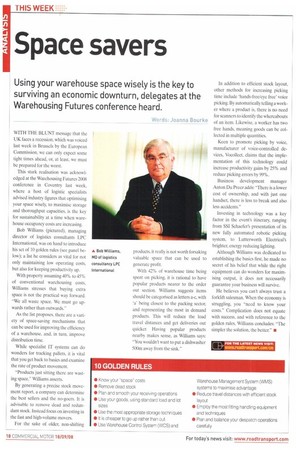Space savers
Page 18

If you've noticed an error in this article please click here to report it so we can fix it.
Using your warehouse space wisely is the key to surviving an economic downturn, delegates at the Warehousing Futures conference heard.
Words: Joanna Bourke WITH THE BLUNT message that the UK faces a recession, which was voiced last week in Brussels by the European Commission, we can only expect some tight times ahead, or, at least, we must be prepared for the worst.
This stark realisation was acknowledged at the Warehousing Futures 2008 conference in Coventry last week, where a host of logistic specialists advised industry figures that optimising your space wisely, to maximise storage and thoroughput capacities, is the key for sustainability at a time when warehouse occupancy costs are increasing.
Bob Williams (pictured). managing director of logistics consultants LPC International, was on hand to introduce his set of 10 golden rules (see panel below); a list he considers as vital for not only maintaining low operating costs. but also for keeping productivity up.
With property assuming 40% to 45% of conventional warehousing costs, Williams stresses that buying extra space is not the practical way forward. "We all waste space. We must go upwards rather than outwards."
As the list proposes, there are a variety of space-saving mechanisms that can be used for improving the efficiency of a warehouse, and, in turn, improve distribution time.
While specialist IT systems can do wonders for tracking pallets, it is vital that you get back to basics and examine the rate of product movement.
"Products just sitting there are wasting space," Williams asserts.
By generating a precise stock movement report, a company can determine the best sellers and the no-goers. It is advisable to remove dead and redundant stock. Instead focus on investing in the fast and high-volume movers.
For the sake of older, non-shifting products, it really is not worth forsaking valuable space that can be used to generate profit.
With 42% of warehouse time being spent on picking. it is rational to have popular products nearer to the order out section. Williams suggests items should be categorised as letters a-c, with 'a' being closest to the packing sector, and representing the most in demand products. This will reduce the load travel distances and get deliveries out quicker. Having popular products nearby makes sense. as Williams says: "You wouldn't want to put a dishwasher 500m away from the sink." In addition to efficient stock layout, other methods for increasing picking time include 'hands-free/eye free' voice picking. By automatically telling a worker where a product is, there is no need for scanners to identify the whereabouts of an item. Likewise, a worker has two free hands, meaning goods can be collected in multiple quantities.
Keen to promote picking by voice, manufacturer of voice-controlled devices, Vocollect, claims that the implementation of this technology could increase productivity gains by 25% and reduce picking errors by 99%.
Business development manager Anton Du Preez adds: -There is a lower cost of ownership, and with just one handset, there is less to break and also less accidents."
Investing in technology was a key factor in the event's itinerary ranging from SSI Schaefer's presentation of its new fully automated robotic picking system, to Lutterworth Electrical's brighter, energy reducing lighting.
Although Williams was dedicated to establishing the basics first, he made no secret of his belief that while the right equipment can do wonders for maximising output, it does not necessarily guarantee your business will survive.
He believes you can't always trust a forklift salesman. When the economy is struggling, you "need to know your costs." Complication does not equate with success, and with reference to the golden rules, Williams concludes: "The simpler the solution, the better." II












































































































































































